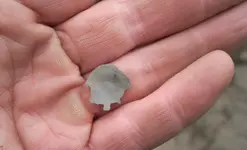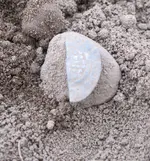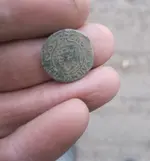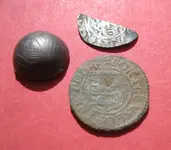WILLIAM BATEMAN (Farthing, 1656)
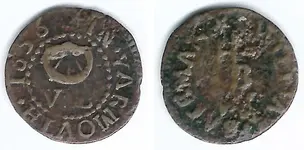
This token has Bateman’s merchant’s mark on one side and a bugle horn on the other. Production of token coinage was technically illegal and all Corporations that had issued them during the 1650s and 1660s had to obtain a Royal Pardon in 1670, cease to issue them, and withdraw them from circulation. Many were sold off in bulk as scrap metal.
FOR THE USE OF THE POOR (Farthing, 1669)
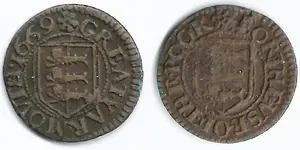
Although officially issued by the town, these tokens were still illegal. They were not produced for ‘workhouse’ payment, but as an act of charity for those in need (the elderly and those unable to work). They weren’t necessarily given solely in the same sense that ‘food stamps’ were issued in modern times, but served another use for the poor. They were the people who were inconvenienced the most by the shortage of Regal small change since they were only able to purchase goods in small amounts and had no availability of credit.
Occasional hoards and deposits demonstrate that these tokens were not segregated from private merchant issues and likely circulated alongside them for general use. Also, bubonic plague had hit Yarmouth in 1665-1666 and, in the aftermath following a large number of deaths, there was concern about civil disorder potentially arising from merchant’s tokens not being honoured. Town tokens rather than individual merchant tokens, helped alleviate those concerns until Regal copper coinage began to appear from around 1672 (albeit in limited quantities).
LET YARMOUTH FLOURISH – W. Absolon (Halfpenny, 1792)
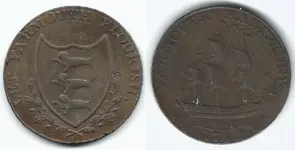
These tokens exist with both a plain edge and with edge lettering that says “PAYABLE AT THE GLASS WAREHOUSE OF W. ABSOLON . X .” William Absolon was a dealer in china and earthenware (and later in glassware) between 1751-1815. He was apprenticed to a potman in Yarmouth and, after being made a Freeman of the town in 1784, he took over another business, his trade card stating that he had a manufactory for enamelling (ie painting) and gilding (ceramics) with coats-of-arms, cyphers, borders etc, and for cutting and engraving glass. Most of his decoration depicted local subjects.
Shortage of small change had again reared its head in the late 18th Century and the Royal Mint turned a blind eye to the issue of tokens until the appearance of coppers produced under contract in 1799 by Matthew Boulton’s Soho Mint in Birmingham. The Mint had rejected an offer from Thomas Williams for the free-of-charge use of his technology for edge lettering on coins as an anti-counterfeiting measure in return for him becoming the supplier of copper from his “Parys Mining Company” in Wales. By 1786, around two-thirds of the copper coins in circulation were counterfeit, and the Mint responded by shutting down production, with no copper coins being struck after 1775 until 1821 (apart from those produced under contract by Boulton).
Many of the older Regal issues had worn so flat that they were unrecognisable and almost anything of approximately the right size, shape and metal composition passed as currency among the general public, whether counterfeit coins or privately issued tokens.
J. HUNTON / BLYTH & Co (Shilling, 1811)
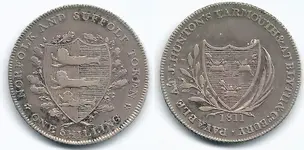
Interesting one, this. Driven in part by the economic effect of the industrial revolution and the boom in prosperity enjoyed by industrialists during the Napoleonic Wars, small silver coins also became short in supply. Tokens began appearing again from 1811 onwards, this time in silver as well as copper and brass.
John Hunton started his career as a ‘slop-seller’ (‘slop’ was the term for cheap, ready-made clothing) and had a business relationship with John Blyth & Co. of Bury St.Edmunds who specialised in ‘Suffolk hemp’ ( a coarse plant fibre used for things like cheap clothing, sacks, horse bedding and to reinforce plaster for building purposes). He went on to become a very wealthy linen-draper.
Not long after this token was issued, he moved his business to London, trading as a ‘mercer’ (an importer of fine fabrics, often from the orient). His luck turned dramatically after some unwise investments, and he lost most of his money speculating in Spanish bonds.
He then began issuing a considerable number of bills of exchange, mostly accepted in the name of Edward Wilkins and purporting to be drawn by the firm of Dickinson & Co. in which he was a partner. Before the majority of them became due, it became apparent that Wilkins had been dead for some time and the bills were forgeries.
Hunton faced trial on 28th October 1828, was found guilty on two counts of forgery as sample charges relating to the fraud, and sentenced to death. Pleas for clemency were rejected, and he was hanged at Newgate Prison on 8th December 1828… one of the last people in Britain to be executed for forgery.
S. LESSY - GROCER & TEA DEALER (Farthing, undated)

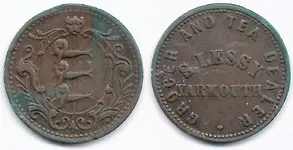
Two different die varieties, issued sometime between 1837-1880 (probably1850's).
F. MAYSTON – GROCER & TEA DEALER (Farthing, undated)
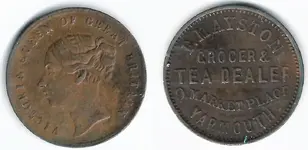
This one has Victoria’s ‘young head’ portrait (as used on pre-1888 coinage) and is mentioned in “The History of Great Yarmouth”, published in 1856, as being “recently in circulation”. Although the general shortage of small coins had been alleviated by Victorian times, tokens continued to be produced, but generally portrayed by the issuers as “advertising pieces” that happened to have the same dimensions as coins (usually farthings).
ROBERT BUMPSTEAD – GROCER &c (Farthing, undated)
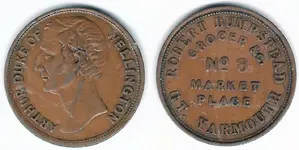
This one has a portrait of the Duke of Wellington (Arthur Wellesley), a national hero since his 1815 victory over Napoleon at the battle of Waterloo, and a popular choice for token obverses. Robert Bumpstead’s known period of operation as a grocer in Yarmouth was between 1850-1879.
HORATIO FENNER (Halfpenny? undated)
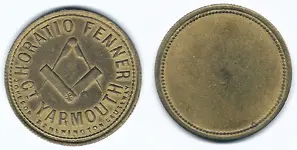
Horatio Fenner came to Yarmouth with his father and brothers sometime between 1851 and 1861, being already established in the fishing trade. Over the next few decades they built their company into one of Yarmouth's largest owners of drifters for herring fishing. Horatio died in 1893, not long after being appointed Port & Haven Commissioner for the town. Although approximately halfpenny-sized, it’s not clear if this uniface token ever circulated as proxy currency, served as a tally for fishmongers, or was purely for advertising purposes.
The token was produced by the Johnson company of Newington Causeway in Southwark, London.



